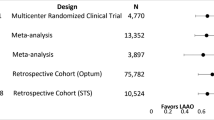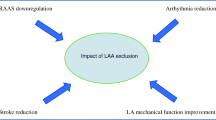Abstract
Background
Atrial fibrillation is the most common cardiac arrhythmia and is a major risk factor for stroke, with an incidence rate of 4–5% per year. The use of DOACs is recommended for specific patient populations however the risk of bleeding commonly precludes their use. Left atrial appendage occlusion is a relatively novel procedure recommended for such patients. We set out to analyse the initial success and safety of this procedure in a single site.
Results
Twenty patients were included in the study with an average age of 81 years. Seventy percent (n = 14) were male. Ninety percent (n = 18) had a history of major bleeding, an absolute contraindication to anticoagulation. The mean CHADS2VaSc and HASBLED scores were 4.75 and 3.7, respectively. The technical success rate was 95% comparable with existing data. The procedural success rate in our study was 80%. The most frequent complication was cardiac tamponade, occurring in 10% of cases.
Conclusion
We report lower technical success and procedural success rates in an older population cohort than historically studied, 90% of whom had an absolute contraindication to oral anticoagulation, with higher CHADS2VaSc and HASBLED scores than commonly studied.


Similar content being viewed by others
Abbreviations
- EU:
-
European Union
- DOAC:
-
Direct-acting oral anticoagulant
- LAAO:
-
Left atrial appendage occlusion
- ACP:
-
Amplatzer cardiac plug
- MAE:
-
Major adverse event
- VARC2:
-
Valve Academic Research Consortium 2
- BARC:
-
Bleeding Academic Research Consortium
- TOE:
-
Trans oesophageal echocardiogram
- TIA:
-
Transient ischaemic attack
References
Friberg L, Hammar N, Rosenqvist M (2010) Stroke in paroxysmal atrial fibrillation: report from the Stockholm Cohort of Atrial Fibrillation. Eur Heart J 31(8):967–975
Psaty BM, Manolio TA, Kuller LH et al (1997) Incidence of and risk factors for atrial fibrillation in older adults. Circulation 96(7):2455–2461
Stewart S, Hart C, Hole D, McMurray J (2001) Population prevalence, incidence, and predictors of atrial fibrillation in the Renfrew/Paisley study. Heart 86(5):516–521
Ruigómez A, Johansson S, Wallander M-A, Rodrı́guez LAGa (2002) Incidence of chronic atrial fibrillation in general practice and its treatment pattern. J Clin Epidemiol 55(4):358–63
Lloyd-Jones DM, Wang TJ et al (2004) Lifetime risk for development of atrial fibrillation: the Framingham Heart Study. Circulation 110(9):1042–1046
Hildick-Smith D, Landmesser U, Camm AJ et al (2020) Left atrial appendage occlusion with the Amplatzer™ Amulet™ device: full results of the prospective global observational study. Eur Heart J 41(30):2894–2901
Recommendations: Atrial fibrillation: Diagnosis and management: Guidance [Internet]. NICE (2021) [cited 2022Dec22]. Available from: https://www.nice.org.uk/guidance/ng196/chapter/Recommendations#stroke-prevention
Gage BF, Boechler M, Doggette AL et al (2000) Adverse outcomes and predictors of underuse of antithrombotic therapy in medicare beneficiaries with chronic atrial fibrillation. Stroke 31(4):822–827
Hori M, Matsumoto M, Tanahashi N et al (2012) Rivaroxaban vs. warfarin in Japanese patients with atrial fibrillation–the J-ROCKET AF study–. Circ J CJ-12–0454
Halvorsen S, Atar D, Yang H et al (2014) Efficacy and safety of apixaban compared with warfarin according to age for stroke prevention in atrial fibrillation: observations from the ARISTOTLE trial. Eur Heart J 35(28):1864–1872
Connolly SJ, Wallentin L, Ezekowitz MD et al (2013) The long-term multicenter observational study of dabigatran treatment in patients with atrial fibrillation (RELY-ABLE) study. Circulation 128(3):237–243
Hart RG, Pearce LA, Aguilar MI (2007) Meta-analysis: antithrombotic therapy to prevent stroke in patients who have nonvalvular atrial fibrillation. Ann Intern Med 146(12):857–867
Yang E (2014) A clinician’s perspective: novel oral anticoagulants to reduce the risk of stroke in nonvalvular atrial fibrillation–full speed ahead or proceed with caution? Vasc Health Risk Manag 10:507
Majeed A, Hwang H-G, Connolly SJ et al (2013) Management and outcomes of major bleeding during treatment with dabigatran or warfarin. Circulation 128(21):2325–2332
Reddy VY, Doshi SK, Kar S et al (2017) 5-year outcomes after left atrial appendage closure: from the PREVAIL and PROTECT AF trials. J Am Coll Cardiol 70(24):2964–2975
Blackshear JL, Odell JA (1996) Appendage obliteration to reduce stroke in cardiac surgical patients with atrial fibrillation. Ann Thorac Surg 61(2):755–759
Khan AA, Lip GY (2019) The prothrombotic state in atrial fibrillation: pathophysiological and management implications. Cardiovasc Res 115(1):31–45
Watson T, Shantsila E, Lip GY (2009) Mechanisms of thrombogenesis in atrial fibrillation: Virchow’s triad revisited. The Lancet 373(9658):155–166
Madden JL (1949) Resection of the left auricular appendix: a prophylaxis for recurrent arterial emboli. J Am Med Assoc 140(9):769–772
Johnson WD, Ganjoo A, Stone CD, Srivyas RC et al (2000) The left atrial appendage: our most lethal human attachment! Surgical implications. Eur J Cardiothorac Surg 17(6):718–722
Members ATF, Camm AJ, Lip GY et al (2012) 2012 focused update of the ESC Guidelines for the management of atrial fibrillation: an update of the 2010 ESC Guidelines for the management of atrial fibrillation developed with the special contribution of the European Heart Rhythm Association. Eur Heart J 33(21):2719–2747
Glikson M, Wolff R, Hindricks G et al (2020) EHRA/EAPCI expert consensus statement on catheter-based left atrial appendage occlusion–an update. EP Europace 22(2):184
Park JW, Bethencourt A, Sievert H et al (2011) Left atrial appendage closure with Amplatzer cardiac plug in atrial fibrillation: initial European experience. Catheter Cardiovasc Interv 77(5):700–706
Urena M, Rodés-Cabau J, Freixa X et al (2013) Percutaneous left atrial appendage closure with the AMPLATZER cardiac plug device in patients with nonvalvular atrial fibrillation and contraindications to anticoagulation therapy. J Am Coll Cardiol 62(2):96–102
Nietlispach F, Gloekler S, Krause R et al (2013) Amplatzer left atrial appendage occlusion: single center 10-year experience. Catheter Cardiovasc Interv 82(2):283–289
Meerkin D, Butnaru A, Dratva D et al (2013) Early safety of the Amplatzer Cardiac Plug™ for left atrial appendage occlusion. Int J Cardiol 168(4):3920–3925
Freixa X, Chan J, Tzikas A et al (2013) The Amplatzer™ Cardiac Plug 2 for left atrial appendage occlusion: novel features and first-in-man experience. EuroIntervention: journal of EuroPCR in collaboration with the Working Group on Interventional Cardiology of the European Society of Cardiology 8(9):1094–8
Bajaj NS, Parashar A, Agarwal S et al (2014) Percutaneous left atrial appendage occlusion for stroke prophylaxis in nonvalvular atrial fibrillation: a systematic review and analysis of observational studies. JACC: Cardiovasc Interve 7(3):296–304
Tzikas A, Shakir S, Gafoor S et al (2016) Left atrial appendage occlusion for stroke prevention in atrial fibrillation: multicentre experience with the AMPLATZER Cardiac Plug. EuroIntervention 11(10):1170–1179
Tzikas A, Holmes DR, Gafoor S et al (2017) Percutaneous left atrial appendage occlusion: the Munich consensus document on definitions, endpoints, and data collection requirements for clinical studies. Ep Europace 19(1):4–15
Kappetein AP, Head SJ, Leon MB (2012) The Valve Academic Research Consortium-2 consensus document. J Am Coll Cardiol 60:1438–1454
Freixa X, Abualsaud A, Chan J et al (2014) Left atrial appendage occlusion: initial experience with the Amplatzer™ Amulet™. Int J Cardiol 174(3):492–496
Reddy VY, Holmes D, Doshi SK et al (2011) Safety of percutaneous left atrial appendage closure: results from the Watchman Left Atrial Appendage System for Embolic Protection in Patients with AF (PROTECT AF) clinical trial and the Continued Access Registry. Circulation 123(4):417–424
Holmes DR, Kar S, Price MJ et al (2014) Prospective randomized evaluation of the Watchman Left Atrial Appendage Closure device in patients with atrial fibrillation versus long-term warfarin therapy: the PREVAIL trial. J Am Coll Cardiol 64(1):1–12
Author information
Authors and Affiliations
Corresponding author
Ethics declarations
Ethics approval and consent to participate
Ethical approval was granted by the Cork Research Ethics Committee and this study was performed in accordance with standards pertaining to the same.
Additional information
Publisher's Note
Springer Nature remains neutral with regard to jurisdictional claims in published maps and institutional affiliations.
Rights and permissions
Springer Nature or its licensor (e.g. a society or other partner) holds exclusive rights to this article under a publishing agreement with the author(s) or other rightsholder(s); author self-archiving of the accepted manuscript version of this article is solely governed by the terms of such publishing agreement and applicable law.
About this article
Cite this article
Killian, M., O’Regan, J., Torre, R. et al. Left atrial appendage occlusion in an older population cohort. Ir J Med Sci 192, 2707–2712 (2023). https://doi.org/10.1007/s11845-023-03346-1
Received:
Accepted:
Published:
Issue Date:
DOI: https://doi.org/10.1007/s11845-023-03346-1




